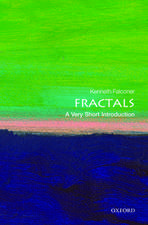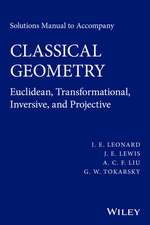Homogeneous Structures on Riemannian Manifolds: London Mathematical Society Lecture Note Series, cartea 83
Autor F. Tricerri, L. Vanheckeen Limba Engleză Paperback – 22 iun 1983
Din seria London Mathematical Society Lecture Note Series
- 11%
 Preț: 464.95 lei
Preț: 464.95 lei - 8%
 Preț: 446.84 lei
Preț: 446.84 lei - 14%
 Preț: 1192.30 lei
Preț: 1192.30 lei - 8%
 Preț: 423.03 lei
Preț: 423.03 lei - 11%
 Preț: 587.20 lei
Preț: 587.20 lei - 8%
 Preț: 448.27 lei
Preț: 448.27 lei -
 Preț: 349.77 lei
Preț: 349.77 lei - 8%
 Preț: 389.36 lei
Preț: 389.36 lei - 9%
 Preț: 710.05 lei
Preț: 710.05 lei - 8%
 Preț: 460.72 lei
Preț: 460.72 lei - 8%
 Preț: 402.17 lei
Preț: 402.17 lei -
 Preț: 358.07 lei
Preț: 358.07 lei - 8%
 Preț: 410.87 lei
Preț: 410.87 lei -
 Preț: 295.14 lei
Preț: 295.14 lei - 8%
 Preț: 411.75 lei
Preț: 411.75 lei - 8%
 Preț: 521.93 lei
Preț: 521.93 lei - 11%
 Preț: 604.05 lei
Preț: 604.05 lei - 8%
 Preț: 410.56 lei
Preț: 410.56 lei - 11%
 Preț: 674.85 lei
Preț: 674.85 lei - 11%
 Preț: 461.52 lei
Preț: 461.52 lei - 8%
 Preț: 531.21 lei
Preț: 531.21 lei - 8%
 Preț: 496.10 lei
Preț: 496.10 lei - 11%
 Preț: 679.16 lei
Preț: 679.16 lei -
 Preț: 369.80 lei
Preț: 369.80 lei - 11%
 Preț: 568.43 lei
Preț: 568.43 lei - 14%
 Preț: 695.32 lei
Preț: 695.32 lei - 11%
 Preț: 486.33 lei
Preț: 486.33 lei -
 Preț: 307.10 lei
Preț: 307.10 lei -
 Preț: 443.60 lei
Preț: 443.60 lei - 11%
 Preț: 482.75 lei
Preț: 482.75 lei -
 Preț: 314.39 lei
Preț: 314.39 lei -
 Preț: 311.51 lei
Preț: 311.51 lei -
 Preț: 308.63 lei
Preț: 308.63 lei -
 Preț: 313.47 lei
Preț: 313.47 lei -
 Preț: 315.11 lei
Preț: 315.11 lei - 11%
 Preț: 483.09 lei
Preț: 483.09 lei -
 Preț: 434.32 lei
Preț: 434.32 lei -
 Preț: 312.10 lei
Preț: 312.10 lei -
 Preț: 308.84 lei
Preț: 308.84 lei - 11%
 Preț: 434.75 lei
Preț: 434.75 lei -
 Preț: 396.53 lei
Preț: 396.53 lei -
 Preț: 442.68 lei
Preț: 442.68 lei - 11%
 Preț: 415.33 lei
Preț: 415.33 lei -
 Preț: 396.15 lei
Preț: 396.15 lei -
 Preț: 347.50 lei
Preț: 347.50 lei - 11%
 Preț: 415.67 lei
Preț: 415.67 lei -
 Preț: 301.69 lei
Preț: 301.69 lei -
 Preț: 393.81 lei
Preț: 393.81 lei - 11%
 Preț: 456.52 lei
Preț: 456.52 lei - 11%
 Preț: 481.53 lei
Preț: 481.53 lei
Preț: 309.39 lei
Nou
Puncte Express: 464
Preț estimativ în valută:
59.21€ • 61.17$ • 49.28£
59.21€ • 61.17$ • 49.28£
Carte tipărită la comandă
Livrare economică 25 martie-08 aprilie
Preluare comenzi: 021 569.72.76
Specificații
ISBN-13: 9780521274890
ISBN-10: 0521274893
Pagini: 144
Dimensiuni: 152 x 228 x 8 mm
Greutate: 0.22 kg
Editura: Cambridge University Press
Colecția Cambridge University Press
Seria London Mathematical Society Lecture Note Series
Locul publicării:Cambridge, United Kingdom
ISBN-10: 0521274893
Pagini: 144
Dimensiuni: 152 x 228 x 8 mm
Greutate: 0.22 kg
Editura: Cambridge University Press
Colecția Cambridge University Press
Seria London Mathematical Society Lecture Note Series
Locul publicării:Cambridge, United Kingdom
Cuprins
1. The theorem of Ambrose and Singer; 2. Homogeneous Riemannian structures; 3. The eight classes of homogeneous structures; 4. Homogeneous structures on surfaces; 5. Homogeneous structures of type T1; 6. Naturally reductive homogeneous spaces and homogeneous structures of type T3; 7. The Heisenberg group; 8. Examples and the inclusion relations; 9. Generalized Heisenberg groups; 10.Self-dual and anti-self-dual homogeneous structures.
Descriere
The central theme of this book is the theorem of Ambrose and Singer.















